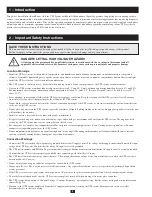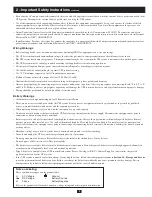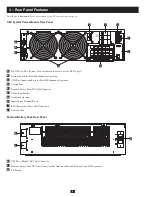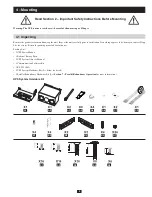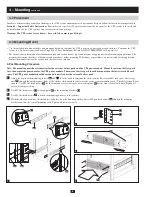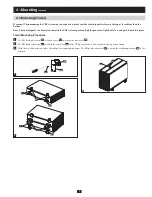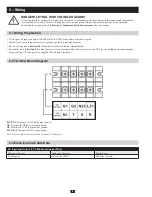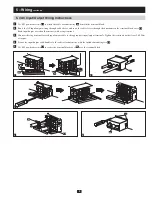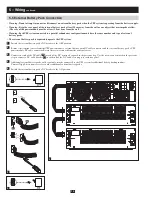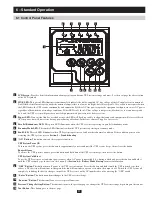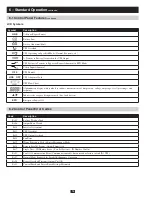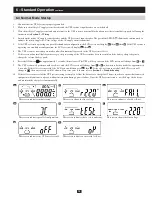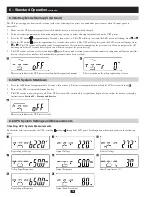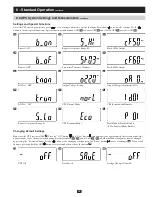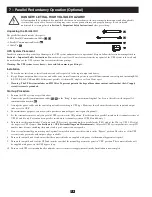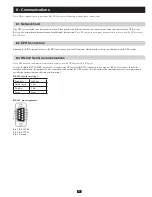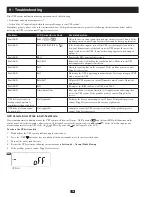
3
2 – Important Safety Instructions
continued
• Even after the AC supply circuit is disconnected, there is a risk of dangerous electrical shock when the external battery pack is connected to the
UPS system. Disconnect the external battery pack before servicing the UPS system.
• Use of this equipment in life support applications where failure of this equipment can reasonably be expected to cause the failure of the life
support equipment or to significantly affect its safety or effectiveness is not recommended. Do not use this equipment in the presence of a
flammable anesthetic mixture with air, oxygen or nitrous oxide.
• Output Protection: An easily accessible disconnect switch must be provided for the AC output circuit (L21-N22). To reduce the risk of fire,
connect the output only to a circuit provided with 45 amperes maximum branch circuit overcurrent protection in accordance with the National
Electrical Code (NEC), ANSI/NFPA 70.
• Input Protection: To reduce the risk of fire, connect the input only to a circuit provided with 65 amperes maximum branch circuit overcurrent
protection in accordance with the National Electrical Code (NEC), ANSI/NFPA 70.
Wiring Warnings
• Refer to all applicable local, state and national codes (including NEC) for appropriate cable size and ratings.
• The UPS system contains hazardous high voltages that have the potential to cause personal injury or death from electric shock.
• The UPS system has its own energy source. The output terminals may be live even when the UPS system is not connected to a utility power source.
• The UPS system must be suitably grounded according to all applicable electrical wiring regulations.
• De-energize all input and output power sources before installing cables or making electrical connections.
• Use flexible cable of sufficient length to permit UPS system servicing.
• Use 75° C minimum copper wire for AC input/output connections.
• Tighten all connections with a torque of at least 2.60 N•m (23 in•lb).
• Confirm that all cables are marked correctly according to their purpose, phase, polarity and diameter.
• Observe proper polarity by connecting negative to negative and positive to positive. Observe proper phase by connecting R to R, S to S, T to T
and N to N. Failure to observe proper phase or polarity will damage the UPS system and create a risk of personal injury and property damage.
• Wiring should be performed by trained, qualified electricians only.
Battery Warnings
• Allow batteries to charge uninterrupted for 12 hours after installation.
• There are no user-serviceable parts inside the UPS system. Battery service or replacement must be performed or supervised by qualified
service personnel familiar with batteries and the required precautions.
• When replacing batteries, replace only with the same quantity, type and capacity.
• Do not connect or disconnect batteries when the UPS system is operating from the battery supply. Disconnect the charging source prior to
connection or disconnecting battery terminals.
• Batteries present a risk of electrical shock from high short-circuit current. Observe these precautions when working with batteries: Remove
watches, rings or other metal objects. Use tools with insulated handles. Wear rubber gloves and boots. Do not place tools or metal parts on
batteries. Disconnect the charging source prior to connecting or disconnecting battery terminals. Do not short or bridge the battery terminals
with any object.
• Hazardous voltage may exist between the battery terminals and ground – test before touching.
• Turn off and unplug the UPS system before performing battery replacement.
• Do not open or mutilate batteries. Released electrolyte is harmful to the skin and eyes. It may be toxic
• Do not dispose of batteries in a fire. They may explode.
• The batteries are recyclable. Refer to local codes for disposal requirements. Do not dispose of batteries except through approved channels in
accordance with all applicable local, state and national regulations.
• Tripp Lite offers a complete line of UPS system Replacement Battery Cartridges (R.B.C.). Contact Tripp Lite to determine the specific
replacement battery for the UPS system.
• If the UPS system is unused or placed in storage for any length of time, follow the recharging instructions in
Section 11 – Storage and Service
to avoid a permanent loss of battery capacity. Failure to recharge the batteries periodically may cause permanent battery damage. Battery
damage caused by failure to follow the recharging instructions will not be covered under warranty.
Note on Labeling
These symbols may appear on the product label:
V~
AC Voltage
V DC Voltage
Ø
Phase
Refer to the product label for model numbers, voltage ratings and other important information.
Ground
+
Battery Positive
-
Battery Negative


